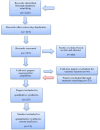Comparing Early-Stage Breast Cancer Patients with Sentinel Lymph Node Metastasis with and without Completion Axillary Lymph Node Dissection: A Systematic Review and Meta-Analysis
- PMID: 36037108
- PMCID: PMC9741898
- DOI: 10.31557/APJCP.2022.23.8.2561
Comparing Early-Stage Breast Cancer Patients with Sentinel Lymph Node Metastasis with and without Completion Axillary Lymph Node Dissection: A Systematic Review and Meta-Analysis
Abstract
Background: Currently, the standard method for staging and treatment of axillary lymph nodes for early-stage breast cancer is sentinel lymph node biopsy (SLNB), while axillary lymph node dissection (ALND) is used in cases with palpable axillary lymph nodes or positive SLNB cases. The aim of this review was to compare overall survival (OS), disease-free survival (DFS), and axillary recurrence in early-stage breast cancer patients underwent SLNB or SLNB and completion ALND.
Methods: The databases of PubMed, Scopus, and Cochrane Library were searched using the key words of "breast cancer", "axillary lymph node dissection", and "sentinel lymph node dissection". In addition, other sources were searched for ongoing studies (i.e., clinicaltrials.gov). The clinical trials were evaluated based on the Jadad quality criteria, and cohort studies were evaluated according to the STROBE criteria. At the end of the search, the articles were screened independently by two reviewers to check their eligibility to be included in the study. Afterwards, the data were extracted independently by two researchers.
Results: After searching the databases, 169 papers were retrieved. However, after removing the duplicates and studying the titles and abstracts of these papers, only ten ones underwent further investigation. After reading full-text of each article, four studies were finalized. Following a manual search, 27 papers were entered into the study for the final evaluation, 11 of which were included in the meta-analysis based on the inclusion and exclusion criteria. The findings showed no significant differences in OS, DFS, and axillary recurrence in early-stage breast cancer patients underwent SLNB or SLNB and completion ALND.
Conclusion: The findings did not confirm that ALND improved OS, DFS, and axillary recurrence in patients who were clinically node-negative and positive SLNB.
Keywords: axillary lymph node dissection; early-stage breast cancer; sentinel lymph node biopsy; survival.
Conflict of interest statement
The authors declare no conflicts of interest.
Figures








References
-
- Bansal M, Mohanti BK. Sentinel lymph node biopsy, axillary dissection and breast cancer: Radiation oncologist’s viewpoint. Nat Med J India. 2002;15:154–7. - PubMed
-
- Bilimoria KY, Bentrem DJ, Hansen NM, et al. Comparison of sentinel lymph node biopsy alone and completion axillary lymph node dissection for node-positive breast cancer. J Clin Oncol. 2009;27:2946–53. - PubMed
-
- Burak Jr WE, Hollenbeck ST, Zervos EE, et al. Sentinel lymph node biopsy results in less postoperative morbidity compared with axillary lymph node dissection for breast cancer. Am J Surg. 2002;183:23–7. - PubMed
-
- Canavese G, Bruzzi P, Catturich A, et al. Sentinel Lymph Node Biopsy Versus Axillary Dissection in Node-Negative Early-Stage Breast Cancer: 15-Year Follow-Up Update of a Randomized Clinical Trial. Ann Surg Oncol. 2016;23:2494–500. - PubMed
Publication types
MeSH terms
LinkOut - more resources
Full Text Sources
Medical

